Spoiler warning: Game of Thrones through season 5, and A Song of Ice and Fire through A Feast for Crows
Content warning: racism, sexism, homophobia, incest
Seven save us, in this installation of A Song of Pins and Needles, we’re examining the intersectional failure that is show!Dorne (hereinafter known as “Porne”).
Porne – and the dreckitude that comes from it – is starkly different from costumes we’ve explored in the past. Daenerys, Margeary, Sansa, Cersei, and Catelyn are all white (physically and coded) and Western (from Westeros… get it?). While the Dornish from the books are technically in Westeros, they are extremely “othered” by the rest of the seven kingdoms. For the purposes of this costuming analysis, keep in mind that the Dornish are considered different from the rest of Westeros, in much the same way white Europeans considered brown native people to be “othered” and different.
George R.R. Martin goes to great lengths to show the reader that the Westerosi view of Dorne is not only incorrect, but overtly racist. Martin’s story offers a critique on the way people “other” each other, and how ingrained racism can slide by unnoticed. For example, Tyrion completely believes the Dornish come in three distinct “types”, and that those types have certain physical and personal characteristics. In fact, the Dornish are just as diverse as the rest of Westeros, and what Tyrion believes is a racist categorization of an “othered” nation. George R.R. Martin is also critiquing the fantasy genre, since fantasy stories often include large masses of fictional people who all share common features (think: elves are graceful, dwarves like to drink, or even Vulcans are logical and Klingons are angry). The use of multiple point of views allows the reader to explore this problem with modern society and this fantasy trope in great depth, and makes the reader challenge their own biases.
And then there’s Porne.
Porne is nothing like Dorne. Porne is a place constructed based on those racist stereotypes, as if the writers took the racist Westerosi view of Dorne at face value. As the creators, David Benioff and Dan Weiss (“D&D”) have said,
“Of all the places in Westeros you’d ever want to live, the Dornish seem to have figured out the right approach to life. It’s the one most aligned with what our approach to life would be if we weren’t making this show. It’s our Brazil—we dream of Dorne and the way they do things down there.” —Dan Weiss
This is, of course, insane. Brazilians do not approach life any differently than non-Brazilians. Surprisingly, South Americans are just as diverse as North Americans – they work and go to school and have families, just like white people. But it seems D&D took the idea that “All the Dornish do is fight and fuck,” and D&D were like:

It’s important to understand the backdrop of racism in both the storytelling and writing as we turn our attention to costuming. I believe this is the plot where the poor writing permeates the costuming the most. The simple fact that D&D started from a racist place, and purposefully treated the Dornish as “others,” absolutely affected the costume design.
For the purposes of this analysis, we will look at Ellaria Sand (“Faullaria”), the Sand Snakes (“the Sand Fakes”), and Princess Myrcella (“Madison”). I won’t be looking at Oberyn, Doran, or Areo Hotah, because frankly their costumes are fine.
As we move forward, keep these two definitions in mind:
- Watsonian analysis: looking at the way a costume functions within the universe; how it is explained in the show
- Doylist analysis: looking at the reasons a costume came to be as a form of art created by real people; analyzing and critiquing real-world explanations
Now let us begin the task of deconstructing the costumes of Porne in this edition of A Song of Pins and Needles.
Brazilians Wear Bikinis
I could easily write another essay on all the ways Faullaria is a racist caricature based on her dialogue and actions in just season four alone, but here I’ll focus on the way they dress this poor woman. This is her dress that she wore to the royal wedding.
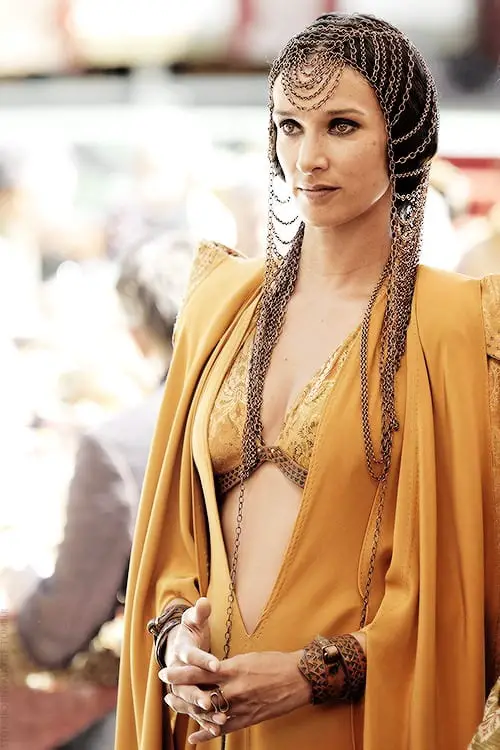
This is around the time in the show where the ability to give it any kind of Watsonian analysis becomes difficult, but let’s try. In-verse, the color of this dress is fine…nothing offensive about a Pornish woman wearing yellow. The shoulder-pads are also fine, I guess. They don’t make a lot of sense, but they also don’t break the suspension of disbelief. Maybe it’s a style in Porne to wear shoulder pads? Is it the 80s down there? Is it a strength thing? Whatever the purpose, it doesn’t matter because it never is of importance on our screens. I actually like the chains-on-the-head-thing, it’s pretty in a unique way and at minimum is visually interesting. It doesn’t seem to have a purpose besides being nice to look at, which is perfectly acceptable for a costume.
The issue here, obviously, is the plunging v-neck that reveals a literal bikini top underneath. I have so many questions. Why did Faullaria think this was appropriate for a wedding? Why would Faullaria, who is the girlfriend of a very powerful man, think this was appropriate to wear outside at all? What is the temperature in Carol’s Landing? And most importantly, how did Faullaria get a commission from the Metacademy of the arts??
First, this is by no stretch of the imagination appropriate for public appearance, let alone a royal wedding. We have seen, within the confines of the show’s universe, that the only women who expose themselves in Westeros are sex workers. Ladies of the court, the vast majority of the time, completely cover their breasts and stomachs. The closest examples we get of vaguely similar plunging necklines are Marg’s first ugly dress and Myranda’s northern dress. We also get some revealing dresses on Marg. The similarities among these women are clear: each is intended to be sexualized in some way, equating revealing clothing with sexuality. We’ve seen this portrayal of the Virgin/Whore complex multiple times on the show. Faullaria adds to that pattern.
However, Faullaria is different because of her race. We must always keep intersectional feminism in mind. Here, we don’t just have a woman on our screens being over-sexualized by her form of dress; we also have a WoC being over-sexualized, AND a bisexual character being over-sexualized. The problem is that these are racist and homophobic stereotypes which still exist today. Faullaria’s presentation feeds those stereotypes, presenting a bad image of women, brown people, and bisexual people to an audience that may not identify with any of those groups. Faullaria’s bikini matters because it perpetuates the bigotry that caused her to wear a bikini in the first place.
Next, I have a Watsonian concern regarding the design of this bikini. It’s not like Faullaria went over to the Gap to get bathing suits for herself (and later her daughters) – people don’t wear bathing suits in this universe. Indeed, women don’t even wear bras (there are other types of undergarments for gowns), so where did the design idea for Faullaria’s bikini even come from? The only other similar costume is Dany’s bikini dress, so maybe the idea came from Essos? I’m just honeypotting at this point. Truly though, the bikini top looks insanely anachronistic and definitely inappropriate for a wedding in the show’s universe.
Doylist-wise, I think the design is pretty easy to understand. The costume department took its queue from D&D that Porne is like Brazil. It’s hot and sexy down there, so their ladies must wear tiny clothes and be sexy. No thought was given to the fact that Carol’s Landing would be a different temperature than Porne, and no thought was given to the acceptability of wearing such a garment to a royal wedding. Unlike a number of other costumes that were overthought in a bad way (see Darth Sansa for details), Faullaria’s wedding outfit reveals a lack of thought. This is just lazy costuming.
Shoulder pads of Justice
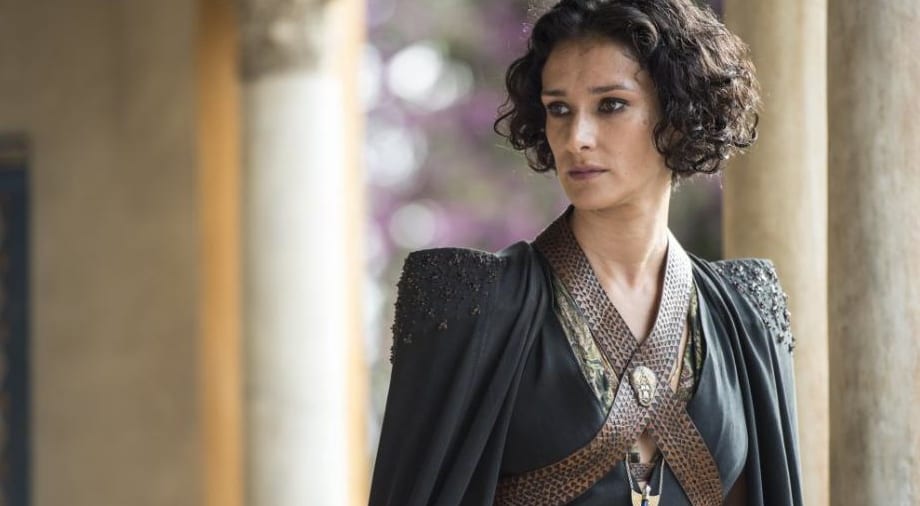
Thank the seven, Faullaria continues her shoulder pad trend as she transitions to her Shoulder Pads of Justice TM. This costume is a perfect mix of stupid and ugly. First of all, Faullaria apparently had someone make her a dress cut in the exact same shape as her last dress – plunging neckline and all – only to wear (1) a dark and spooky bikini top underneath it and (2) the cheapest pieces of pleather you can get at Michael’s over it. She then accessorized with a dumbass necklace (vial of blue antidote), a weird brooch, and her embroidered Shoulder Pads of Justice. It’s like a freshman art student realized their final exam was due in two hours, so they just raided their mom’s closet and threw it together – 80s shoulder pads and all!
In addition to Faullaria getting this dress made, she specifically got it made (1) in black and (2) with sleeves. Okay, I get the black thing – she’s in mourning, sure, whatever. But she’s in Porne. It’s as hot as Brazil down there! And with sleeves? How is this woman alive??
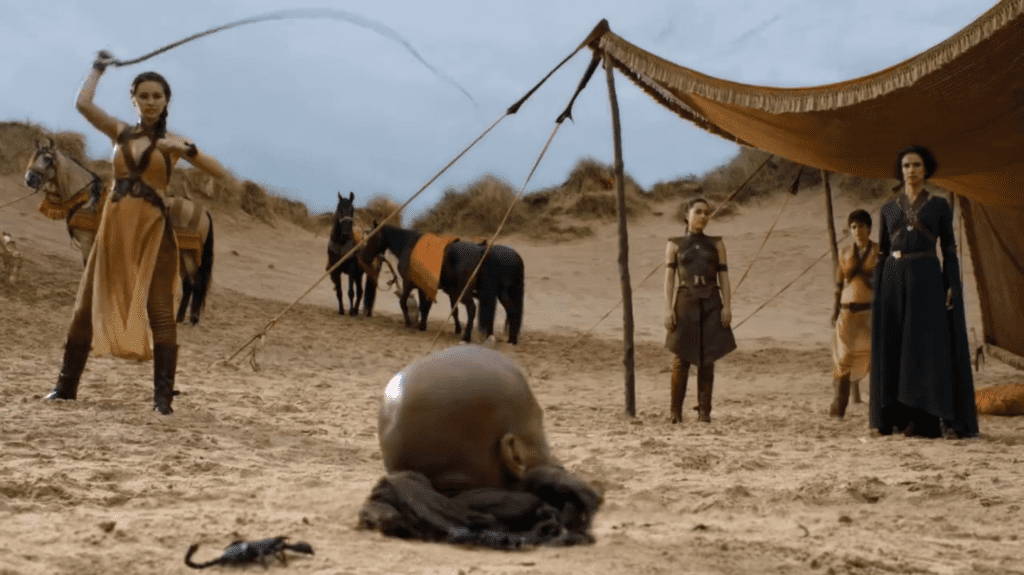
What is the temperature of this world?? It’s warm enough in Carol’s Landing to wear her bikini dress, but not any warmer in Porne? The sleeves seem entirely unnecessary, unless Faullaria is going for that Darth Sansa look. Or maybe she’s just a sith now.
The point is, this poor lady is suffering in the sweltering heat of Porne (which we know is always warm because it’s fantasy-world Brazil—which sidenote is not always warm), and her costume looks dumb as hell. She suffers for nothing.
I can’t begin to understand the doylist purpose behind this one. Maybe they ran out of time to make costumes? More than likely they just did not think it through again. This is also a costume that reeks of laziness. I mean seriously, I’ve seen better original cosplays from my fellow nerds at conventions. And Michelle Clapton is a supposed professional.
Copy + Paste Brown Women
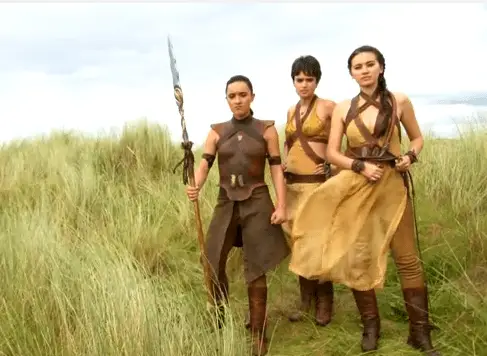
One common and disturbing pattern in human history is the “othering” of different races to justify racism, prejudice, and violence. Part of “othering”, therefore, is stereotyping, which allows an aggressor to put every single person of a certain group into a single, easily understood and easily differentiated box. When people appear to be the exact same, with no defining features or characteristics or individuality, it is much easier to make them objects. Robbing a whole group of their personhood makes them that much easier to destroy.
This type of racism is at play when it comes to the Sand Fakes of GoT. These are three females of color whose characterizations are exactly the same. They have no discernible individual qualities (except that one is good at the slapsies game, I suppose). Most show-watchers don’t even know their names and just refer to them as a collective. The simple fact is that these three characters are a copy+paste of the racist caricature D&D think is Dornish. These are two white male creators depicting three WoC from what they perceive as a foreign nation as a homogeneous group. This depiction plays right into the “othering” that George R.R. Martin is specifically critiquing in his novels. D&D took that critique at face value instead.
Not surprisingly, the costumes don’t help the situation. From the outset I should say that the Sand Fake’s first appearance costumes are ugly AF. And it’s not for lack of inspiration – the source material provides distinct descriptions for each of the Sand Snakes, showing her individuality and characterization along with her appearance. Alas, this is GoT, and drawing on the source material is simply too high of a bar. Instead, we get what someone’s racist grandmother from High Garden thinks of Dornish women.
“Obara”
“Obara was the eldest Sand Snake, a big-boned woman near to thirty, with the close-set eyes and rat-brown hair of the Oldtown whore who’d birthed her. Beneath a mottled sandsilk cloak of dun and gold, her riding clothes were brown leather, worn and supple… On one hip she wore a coiled whip, across her back a round shield of steel and copper. She had left her spear outside…” – A Feast for Crows, Chapter 2

The casting for Obara is a bit off; the actress is much prettier than the image Martin describes. Obara’s baseborn look is important to her characterization, especially when differentiating the way she acts from her sisters. It adds to the complexity of bastardy in Dorne, since Obara is not only a bastard, but had a low-born mother and a high-born father.
The costuming for Obara is more or less right for her description. That said, the book description of “riding leathers” is pretty vague, allowing the reader to fill in the gaps. Show!Obara’s costume is definitely some kind of leather or pleather, and of the Sand Fakes appears the most logical and functional; though I don’t know how comfortable it is to have a shaped leather chest piece resting directly on your skin (I bet she has a bikini on underneath!)
There is nothing particularly remarkable about this costume, though I must say I’m not surprised they got the “masculine” Sand Fake’s outfit correct. At quick glance, the men’s costumes in this show tend to outpace the women’s, not requiring ridiculous explanations outside of the Watsonian confines. The show runners understand masculinity (read: toxic masculinity), and their understanding rubs off on the costume design.
Note that the biggest controversy regarding Obara was “Nipple-gate,” in other words, the way the audience reacted to her armor having nipples. Not boobs, mind you – the reaction was to the nipples. This was undoubtedly a response to the fact that breasts and nipples are sexualized in media, especially on GoTs, so the presence of nipples in a non-sexual setting confused and bewildered the captive audience. This is just another part of the pattern of sexism we see throughout the series.
“Nymeria”
“Even ahorse, the Lady Nym looked graceful, dressed all in shimmering lilac robes and a great silk cape of cream and copper that lifted at every gust of wind, and made her look as if she might take flight. Nymeria Sand was five-and-twenty, and slender as a willow. Her straight black hair, worn in a long braid bound up with red-gold wire, made a widow’s peak above her dark eyes, just as her father’s had. With her high cheekbones, full lips, and milk-pale skin, she had all the beauty that her elder sister lacked… but Obara’s mother had been an Oldtown whore, whilst Nym was born from the noblest blood of old Volantis.” – A Feast for Crows, Chapter 2
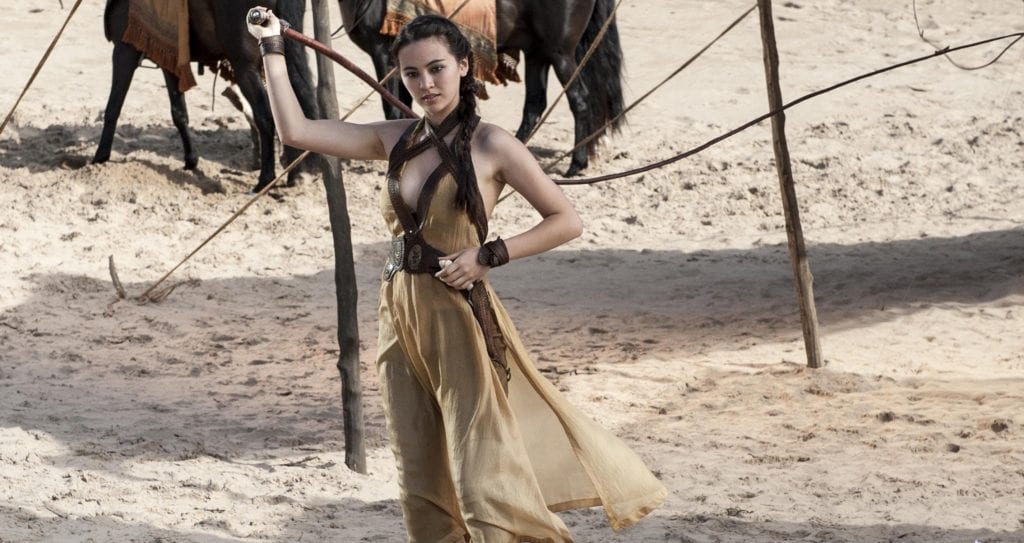
Again, the costume description isn’t particular, but the reader gets a sense of Lady Nym: she is graceful and high-born in how she presents; different from Obara. Indeed, Lady Nym wears a different color from Obara, since she’s in purple while Obara is in yellow and brown. This would have made for great visual diversity between the characters. Maybe that would have affected Show-Nym’s characterization in some way. It at least would have been visually interesting. Instead, we get a copy+paste of Obara. Now we have two light-skinned WoC with black hair and brown eyes in yellow/brown/pleather outfits standing somewhere in the desert. This strikes me as lazy costuming, and it adds to the bad “othering” we see with regards to Porne.
I also have some nitpicky gripes with Nym’s dress. What’s with the leather strap that wraps around her neck? Certainly that’s dangerous – someone could choke her with that, or she could get caught on something and hanged – or it at minimum restrains the movement of her neck. None of the leather on this dress serves any kind of protective purpose. Indeed, her costume falls into some bad tropes when it comes to women’s armor. Last, there’s no vial of antidote hanging between her breasts! How will she ever survive being poisoned?
It’s hard to bolster this costume in a Watsonian way. We know so little about Porne, it’s impossible to know if this is legit Pornish fashion or something totally off the rails. I don’t find the Watsonian analysis particularly enthralling here, since the Doylist issue shine through so blatantly. Even if there was a Watsonian explanation, I don’t know if it would matter because of the racism and sexism issues with this design and the design for the Sand Fakes overall. While generally I believe a solid Watsonian foundation can overcome Doylist issues, in this case, the bigotry involved in scripting and designing these characters is too blatant to ignore.
“Tyene”
“…dressed in a clinging gown of pale blue samite with sleeves of Myrish lace that made her look as innocent as the Maid herself. In one hand was a piece of embroidery she had been working on, in the other a pair of golden needles. Her hair was gold as well, and her eyes were deep blue pools…” – A Feast for Crows, Chapter 2
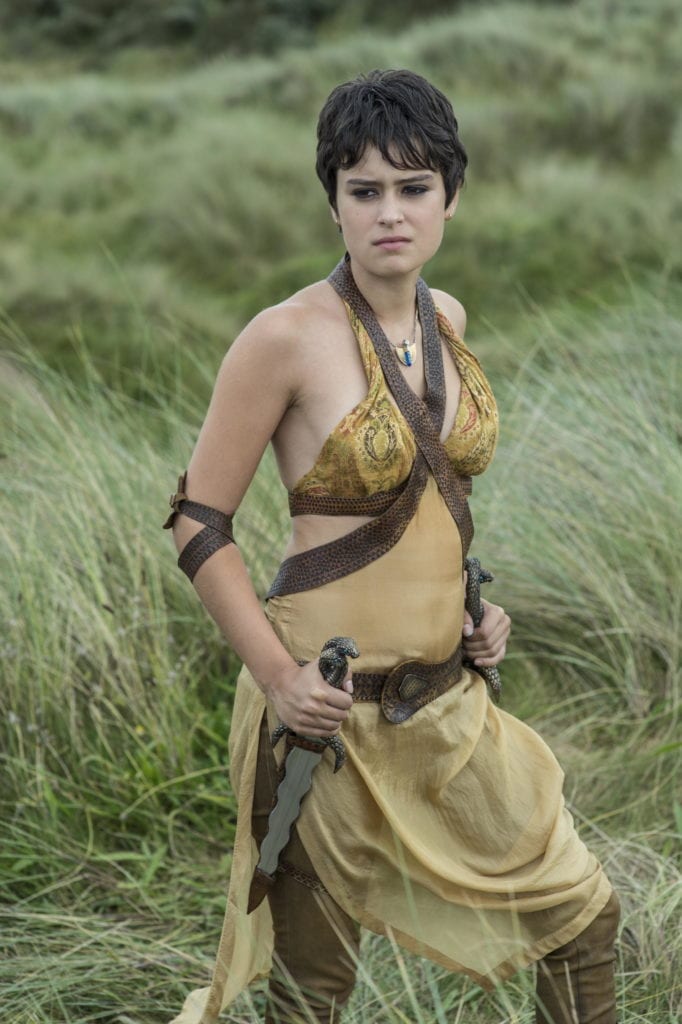
Continuing in the trend, show!Tyene was simply designed to look like the other Dornish women around her, with no discernable individual characteristics. Book!Tyene’s physical appearance, along with her choice of clothing, matter to her story and opinions. She plays off her innocent look to manipulate the world around her and gain agency. Her costuming appeals to that angle, as she always wears these maiden-esque dresses. The fact that show!Tyene looks nothing like her book counterpart is another example of this bad pattern – that the Sand Snakes’ personalities were completely ignored, and that they were designed with broad strokes as generically “Dornish” in a distinctly racist way.
But I’d like to draw your attention to another small detail I stumbled on – something that is perhaps my new favorite honeypot. It’s a bit convoluted, so let’s take it step by step.
First, notice the blue vial necklace Tyene wears.
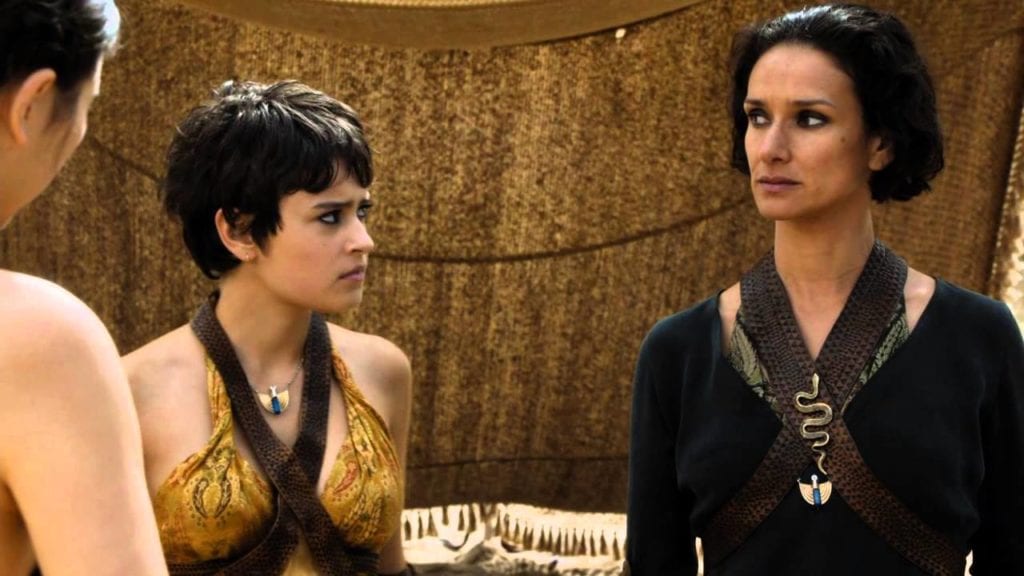
As we know from Tyene’s scene poisoning Bronn, all poison antidotes are carried in necklaces. And indeed, it is confirmed that this blue vial is the antidote to the poison Tyene gave Bronn.
Now, the official honeypot on the time-release poison used on Bronn is that his heart rate had to be up for the poison to take effect – basically that the poison didn’t spread until he got turned on, which upped his heart rate and pulse. BUT we know that can’t be accurate, since the poison was introduced into Bronn’s blood stream mid-battle, when his heart rate certainly was high.

The conclusion being that this poison – which is curable with the blue antidote – is boner-activated. In other words, it requires sexual arousal to work.
Now, remember that Faullaria wears the same blue vial antidote necklace. Indeed, Faullaria is seen wearing the same blue vial antidote necklace in the scene where she poisons Madison. Faullaria kisses Madison and then takes the blue antidote. Madison does not have the antidote, so she dies.
New favorite honeypot: Faullaria killed Madison with the “time release” (read: boner activated) poison!
Think about it – all three poisonings are the same.
- Bronn gets the poison introduced into his system; it begins to take affect once he is sexually aroused; he bleeds from his nose; he is given the blue antidote as the cure.
- Faullaria gets the poison introduced through her skin; it begins to take affect after kissing Madison; she bleeds from the nose; she takes the blue antidote as the cure.
- Madison gets the poison introduced by the kiss; it begins to take affect after she speaks with Jaime; she bleeds from the nose; with no antidote, she dies.
This has a host of bad implications. First, the “high heart rate” explanation doesn’t make any sense here – Madison may have a racing heart because of her conversation with her newly revealed father, but she didn’t really seem that excited, and Faullaria has no reason and no indication of a fast pulse. But that’s irrelevant anyway because we know it’s not possible for this to be time-release caused by a fast pulse, as discussed with Bronn above. Since we know this is boner-activated poison, then that means Faullaria and Madison felt some sexual desire in these scenes. Faullaria may have been turned on by the kiss. I mean that’s weird and gross (Madison is underage), but okay, bad implications are bad for a reason. But Madison, then, must have felt sexual urges towards her father, Jaime.
Their costume details and sloppy writing can reasonably lead to the conclusion that Madison Lannister felt sexy things for her own father.
As for this week’s episode with Cheryl using the poison on Tyene? I guess just chalk that one up to sexy poetic justice. Or we could also admit the poison administration has made no sense for the past three years. Take your pick, but I do find my own amusement in this terrible, terrible honeypot.
Madison and the Puffy Dresses
Moving on from that awful, terrible, no-good, very-bad honeypot, the last things to discuss are the series of pretty prom dresses worn by the Pornish women and Princess Madison. It is, again, impossible to analyze these dresses in a Watsonian way. They are at minimum climate-appropriate, but since we have no barometer on Pornish fashion besides these racist caricatures, there is no way to know if they are acceptable. Comparing these costumes to the books reveals a distinct lack of diversity in dress, but that just goes back to the point that Porne is a racist adaptation of Dorne.

Broadly, I don’t hate these dresses. They’re well-constructed, and they have some beautiful silk ribbon embroidery (holla to my girl Michele Carragher) around the corset and bust-line. They’re flowy and pretty, and delicate in a way we expect a princess to be delicate (which is contrary to the purpose of the Dorne plot, but YOLO).

I still object to them wearing their stupid bikini tops underneath everything, and that’s certainly my least favorite part of this ensemble. Otherwise, I guess they’re fine?
I suppose the problem, then, with the Pornish outfits overall is that they distinctly lack impact. And it’s not surprising considering they are all iterations of the same bad idea, stemming originally from bad intentions. D&D, obviously, were never interested in adapting Dorne or its people. They were interested in their white male Hero TM and his buddy having an awesome bro-trip, funny gags and all. The Pornish women were just props for their shenanigans. So of course they all look the same. And of course they all act the same. Props don’t need individuality. They don’t need humanity. They don’t need personhood. That is why this plotline – and the costume design that came with it – is racist.
The best thing I can say about the Sand Fakes’ and Porne’s costumes is this: at least they aren’t as ugly, stupid, and world-breaking at Talisa.
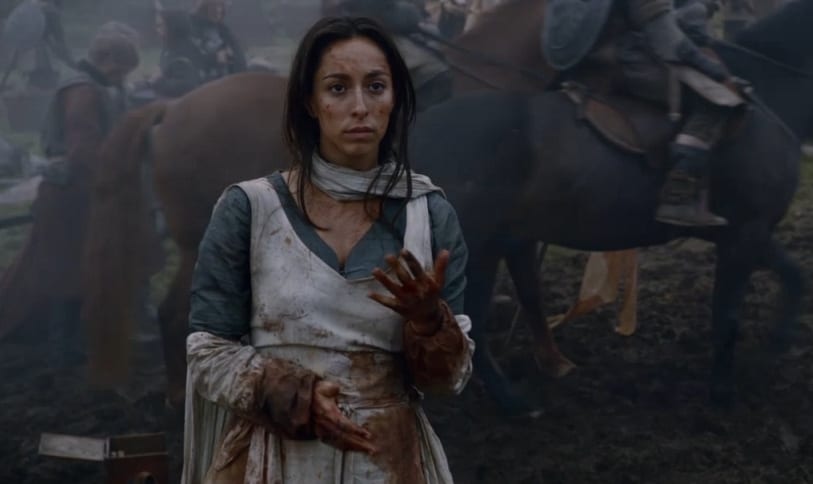
Thank you for joining me on this woeful journey, and keep an eye out for the next installment of A Song of Pins and Needles, dropping sometime after season seven ends.

